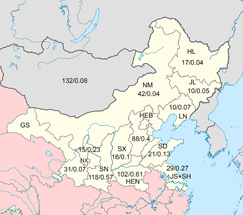Abstract
The dolichopodid fauna of continental Chinese and Russian regions belonging to the East Palaearctic have been selected for a comparative diversity investigation. We gathered information about 654 species of long-legged flies in the studied areas. Regarding the total species number, Primorsky Kray and Republic of Sakha in Russia, Henan and Shaanxi in China, as well as Mongolia are the top five regions, each with more than 100 species known. Cluster analysis of the dolichopodid genera composition allows us to divide all studied territories into two groups: Group A is mixed, since it includes both the Russian regions and the Chinese provinces; Group B includes only Russian regions. Generally, the mathematical analysis of the dolichopodid species supports the uniqueness of Primorsky Kray as the biodiversity center in East Asian Palaearctic. A decrease in the number of known species and biodiversity indices is observed northward, southward and westward of Primorsky Kray. One more possible center is located closely to the Oriental provinces of China (Henan and Shaanxi provinces).
References
- Archibald S. B., Bossert W. H., Greenwood D. R. & Farrell B. D. 2010. Seasonality, the latitudinal gradient of diversity, and Eocene insects. Paleobiology 36(3): 374–398. https://doi.org/10.1666/09021.1
- Bocharnikov V. N., Martynenko A. B., Gluschenko A. B., Gorovoi P. G., Nechaev V. A., Ermoshin V. V., Nedoluzhko V. A., Gorobets K. V. & Dudkin R. V. 2004. Biodiversity of the Far East ecoregional complex.Vladivostok, Apelsin, 188 pp. (in Russian)
- Grichanov I. Ya. 2000. Prohercostomus, a new subgenus of the genus Hercostomus Loew (Diptera: Dolichopodidae) from Baltic amber. Paleontological Journal 5: 82–95. (in Russian)
- Grichanov I. Ya. 2000. Notes on Dolichopodidae (Diptera) from Ukrainian and Baltic amber. An International Journal of Dipterological Research 11(3): 129–131.
- Grichanov I. Ya. 2006. A checklist of Dolichopodidae (Diptera) of Khabarovsk Territory and Jewish Autonomous Region (Russia). International Journal of Dipterological Research 17(3): 167–175.
- Grichanov I. Ya. 2010. A new genus of Medeterinae (Diptera: Dolichopodidae) from Baltic amber. Caucasian Entomological Bulletin 6(2): 209–212. https://doi.org/10.23885/1814-3326-2010-6-2-209-212
- Grichanov I. Ya. 2018. An annotated checklist of Dolichopodidae (Diptera) of Chukotka (Russia) with new records. Acta Biologica Sibirica 4(2): 25–31. https://doi.org/10.14258/abs.v4i2.4120
- Grichanov I. Ya. 2020a. New records of Dolichopodidae (Diptera) from Russian Primorye and notes on some Chinese species. Russian Entomological Journal 29(4): 432–438. https://doi.org/10.15298/rusentj.29.4.12
- Grichanov I. Ya. 2020b. A new species of Sybistroma Meigen (Diptera: Dolichopodidae) from China. Far Eastern Entomologist 418: 1–8. https://doi.org/10.25221/fee.418.1
- Grichanov I. Ya. 2021. Alphabetic list of generic and specific names of predatory flies of the epifamily Dolichopodoidae (Diptera). (Online version). Saint Petersburg: All-Russian Research Institute of Plant Protection. Available from: http://grichanov.aiq.ru/genera3.htm/ (Accessed 1 Apr. 2021).
- Grichanov I. Ya. & Kazerani F. 2014. A new species of Sybistroma Meigen (Diptera: Dolichopodidae) from the Middle East with a key to West-Palaearctic species of the genus. Zootaxa 3866(4): 572–582. https://doi.org/10.11646/zootaxa.3866.4.7
- Grichanov I. Ya. & Selivanova O. O. 2021. An Annotated Checklist Of Dolichopodidae (Diptera) Species From Russian Primorye With New Records. Amurian Zoological Journal 13(2): 202–227. https://doi.org/10.33910/2686-9519-2021-13-1-4-11
- Hammer O. 2001. PAST: Paleontological Statistics Software Package for Education and Data Analysis. Palaeontol Electron 4: 1–9.
- Maslova O. O., Negrobov O. P. & Selivanova O. V. 2010. New data on fauna of genus Dolichopus Latr. (Dolichopodidae, Diptera) of Amur region. Amurskii Zoologicheskii Zhurnal 2(4): 348–349. (in Russian)
- Meunier F. 1907. Monographie des Dolichopodidae de l’ambre de la Baltique. Naturaliste 29(2): 197–199, 209–211, 221–222, 233–235, 245–246, 260–262, 269–271, 281–282.
- Meunier F. 1908. Monographie des Dolichopodidae de l’ambre de la Baltique. Naturaliste 30(2): 7–9, 21–23, 29–30, 45–46, 57–59.
- Myers N., Mittermeier R. A., Mittermeier C. G., da Fonseca G. A. B. & Kent J. 2000. Biodiversity hotspots for conservation priorities. Nature 403(6772): 853–858. https://doi.org/10.1038/35002501
- Negrobov O. P. 1986. To the fauna of Dolichopodidae (Diptera) family of Amur region. Trudy zoologicheskogo Instituta AN SSSR 146: 10–14. (in Russian)
- Negrobov O. P. & Chalaya O. N. 1991. Dolichopodidae (Diptera) of northeastern part of USSR. In: Entomological researches in the northeast of the USSR. Voronezh. 66–80. (in Russian)
- Negrobov O. P., Grichanov I. Ya. & Wang M. 2020. Comparative analysis of the fauna of the family Dolichopodidae (Diptera) of Mongolia and Inner Mongolia of China. In: 11th All-Russian Dipterological Symposium (with international participation), Voronezh, 24–29 August 2020: Мaterials. St.-Petersburg, Russian entomological society: 297–301. https://doi.org/10.47640/978-5-00105-586-0_2020_297
- Negrobov O. P. & Rodionova S. Y. 2004. Faunistic investigations of the family Dolichopodidae (Diptera) of Kamchatka. International Journal of Dipterological Research 15(3): 197–200.
- Olson D. M., Dinerstein E., Wikramanayake E. D., Burgess N. D., Powell G. V. N., Underwood, E. C. et al. 2001. Terrestrial Ecoregions of the World: A New Map of Life on Earth. BioScience 51(11): 933. https://doi.org/10.1641/0006-3568(2001)051[0933:TEOTWA]2.0.CO;2
- Sutherland W. J. 2009. One hundred questions of importance to the conservation of global biological diversity. Conservation biology 23(3): 557–567. https://doi.org/10.1111/j.1523-1739.2009.01212.x
- Ulrich H. 2004. Predation by adult Dolichopodidae (Diptera): a review of literature with an annotated prey-predator list. Studia Dipterologica 11: 369–403.
- Ward J. H. 1963. Hierarchical grouping to optimize an objective function. Journal of the American Statistical Association 58(301): 236–244. https://doi.org/10.1080/01621459.1963.10500845
- Yang D., Zhang L., Wang M. & Zhu Y. 2011. Fauna Sinica, Insecta, Volume 53, Dolichopodidae. Science Press, Beijing, 1912 pp. (in Chinese, with English summary)
- Yang D., Zhang L. L. & Zhang K. Y. 2018. Species Catalogue of China, Volume 2, Animals, Insecta (VI), Diptera (2), Orthorrhaphous Brachycera. Science Press, Beijing, 387 pp.


